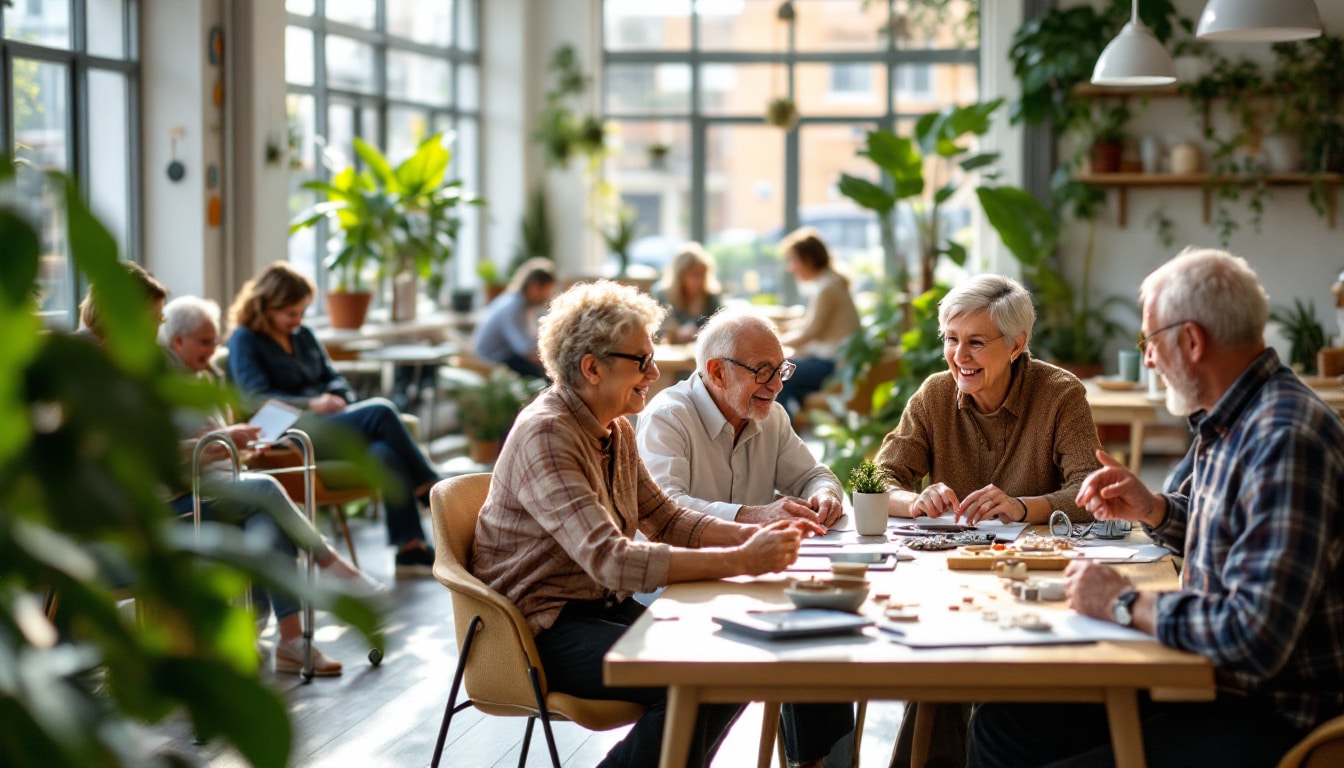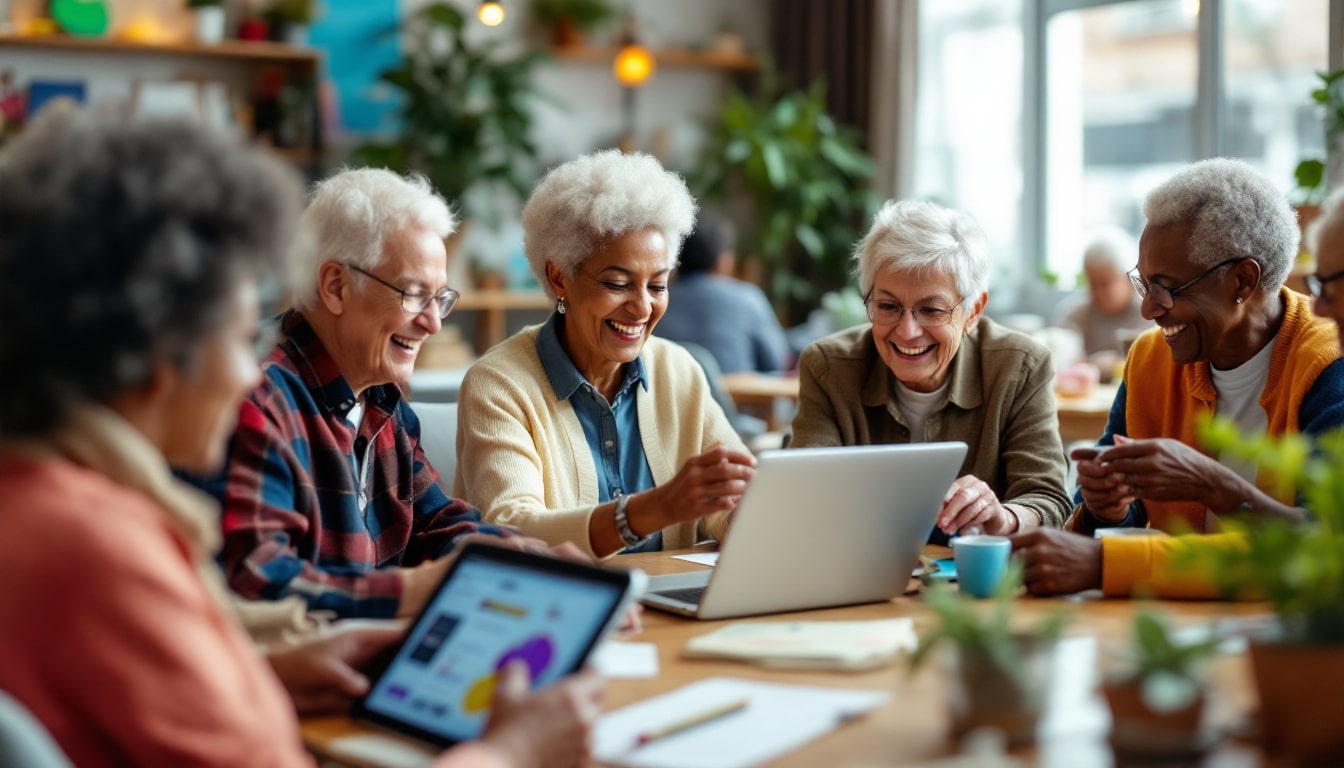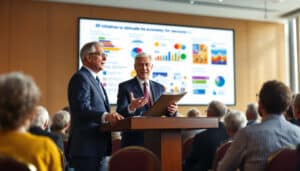At our place, the confidentiality of your data is a top priority.
We use cookies to enhance your experience on our site.
These tools allow us to provide reliable and personalized services.
Our use of cookies and data aims to maintain our Google services, track any interruptions, and protect against spam, fraud, and abuse. We measure the engagement of our audience and the statistics of our site to understand how our services are used and thereby improve their quality. If you choose “Accept all,” we will also use cookies to develop and enhance new services, measure the effectiveness of advertisements, and display personalized content based on your settings. To learn more about managing your privacy settings, select “More options.”

Table des matières
Togglean overview of the silver economy
The silver economy represents a rapidly growing sector, driven by the aging of the global population. With the increase in life expectancy, the needs and expectations of older individuals are evolving, paving the way for numerous economic opportunities. This demographic transformation encourages companies to innovate and adapt their offerings to meet a clientele that is increasingly demanding and diverse.
In this article, we will explore the various facets of the silver economy, highlighting the opportunities it offers, the most impacted sectors, and the emerging trends. At the same time, we will address the importance of data management and privacy protection in this context, reminding of the growing use of technologies to improve the quality of life for seniors while ensuring their security.
what opportunities does the silver economy present?
The silver economy opens the door to a multitude of opportunities for businesses and investors. First of all, the increased demand for products and services tailored to seniors stimulates innovation in various fields such as health, wellness, housing, and leisure. For example, home health monitoring technologies allow for real-time tracking of patients’ conditions, providing better quality of life and reducing unnecessary hospitalizations.
Moreover, the travel and hospitality sector is experiencing a transformation thanks to this demographic trend. Tourist destinations designed for accessibility, offering accessible infrastructures and personalized services, meet the specific needs of older travelers. To learn more about the impact of the silver economy in this field, you can consult this article.
Furthermore, the increase in the older population is boosting the job market, with a growing demand for professionals specialized in elder care, the development of tailored technologies, and the management of real estate dedicated to this population. This dynamic creates a virtuous circle where supply and demand balance, thus promoting a robust and resilient economy.
how is the silver economy transforming the travel and hospitality sector?
The travel and hospitality sector is profoundly impacted by the rise of the silver economy. Seniors represent a significant portion of travelers, seeking comfortable, safe, and tailored travel experiences. Therefore, companies in the sector must innovate to provide personalized services, such as accessible accommodations, flexible travel itineraries, and activities suited to their physical capabilities.
For instance, many travel agencies are developing health tourism programs, combining vacations in soothing locations with medical care or wellness activities. This approach addresses the growing demand from seniors for enriching and beneficial travel experiences for their overall health.
Additionally, hotels are investing in suitable infrastructures, such as spacious rooms, accessible elevators, and specialized concierge services. These improvements aim to ensure a pleasant and hassle-free stay for older travelers, thus enhancing their loyalty and satisfaction.
For a deeper analysis, you can consult this article that explores how China is transforming this sector through the silver economy.
what is the promising future of the silver economy?
The future of the silver economy looks extremely promising, with growth prospects supported by several key factors. Technological innovation plays a central role, facilitating the development of smart solutions to improve the quality of life for seniors. From connected health applications to smart homes and autonomous vehicles, these technological advancements meet the increasing needs of this population.
Additionally, the transformation of social mindsets contributes to better integrating seniors into active society. Encouraging the continued employment of older individuals and valuing their experience and expertise allow for leveraging their skills while addressing the economic challenges associated with demographic aging.
Investment opportunities in specific sectors such as assistive technologies, home services, and leisure activities for seniors offer attractive returns while having a positive social impact. Furthermore, public policies promoting innovation and supporting entrepreneurship in the silver economy strengthen the growth dynamics of this sector.
To further explore future perspectives, read this article that details upcoming opportunities in the silver economy.
how do new technologies support the silver economy?
New technologies are at the heart of supporting and developing the silver economy. They enable the creation of innovative solutions to meet the specific needs of seniors, while facilitating their daily lives and enhancing their autonomy. For example, telemedicine devices allow older individuals to consult healthcare professionals remotely, thus reducing the need for frequent travel.
Moreover, artificial intelligence and Internet of Things (IoT) technologies are used to develop home monitoring systems, ensuring the safety of seniors while providing peace of mind for their loved ones. These smart solutions enable automatic fall detection, health parameter monitoring, and remote management of household appliances.
Digital platforms also play a key role in facilitating access to a variety of services tailored to seniors’ needs. From dedicated medication management applications to social networks specifically designed to maintain social connections, these technological tools foster inclusion and active participation of older individuals in society.
To learn more about the technological potential of the silver economy, consult this article that highlights recent innovations in this field.
what are the strategies for success in the silver economy?
To thrive in the silver economy, companies must adopt specific strategies that respond to the unique expectations and needs of seniors. One key to success lies in a deep understanding of this clientele, taking into account their preferences, physical constraints, and requirements for safety and comfort.
Personalization of offerings is essential to attract and retain older consumers. This involves developing tailored products and services, such as ergonomic equipment, facilitated transport solutions, or personalized health services. Additionally, training staff to provide empathetic and competent customer service contributes to enhancing satisfaction and trust among senior clients.
Collaboration with public institutions and non-governmental organizations can also be beneficial. These partnerships provide access to additional resources, grant opportunities, and create synergies for joint initiatives aimed at improving the quality of life for seniors.
Finally, integrating sustainable and ethical practices into business operations is increasingly valued by consumers. By adopting responsible approaches, companies strengthen their brand image and align with a respectful and inclusive process, essential for long-term success in the silver economy.
how to manage data and privacy in the silver economy?
With the rise of the silver economy, data management and privacy protection have become crucial issues. Companies collect large amounts of personal information to personalize their services and enhance the customer experience. However, it is imperative to ensure that this data is used ethically and securely.
Data protection legislation, such as the GDPR in Europe, imposes strict standards on how personal information is collected, stored, and processed. Companies must ensure they have the explicit consent of users before collecting their data and provide them with tools to manage their privacy preferences.
Moreover, the use of advanced technologies such as encryption and data anonymization helps to enhance the security of sensitive information. These measures ensure that seniors’ data is not misused and remains protected against cyberattacks and privacy violations.
At the same time, it is essential to raise user awareness of best practices in cybersecurity. Information campaigns and training can help seniors understand the importance of protecting their personal data and adopt secure online behaviors.
To better understand the issues related to data privacy in the silver economy, you can read this article that explores new opportunities and challenges in this area.
what innovations are marking the silver economy today?
Innovation is at the heart of the silver economy, enabling the creation of creative and effective responses to the specific needs of seniors. Among the most notable innovations are assistive technologies, such as exoskeletons and mobility aids, which contribute to improving the autonomy and quality of life of older individuals.
Digital health solutions, including medical tracking applications and teleconsultation devices, are revolutionizing the way care is provided. These technologies enable continuous monitoring of seniors’ health, thus facilitating rapid intervention when needed and reducing costs associated with hospital care.
Additionally, the development of virtual and augmented reality offers new possibilities for entertainment and rehabilitation for seniors. These immersive tools can be used for interactive physiotherapy sessions, cognitive stimulation programs, or simply adapted entertainment experiences.
Social innovations, such as skill-sharing platforms and dedicated online communities, also promote inclusion and active participation of seniors in society. By facilitating intergenerational exchanges and valuing elders’ experience, these initiatives strengthen the social fabric and encourage better integration of older individuals.
how do public policies support the silver economy?
Public policies play a decisive role in supporting and developing the silver economy. Governments implement programs and initiatives aimed at improving the living conditions of seniors while stimulating innovation and economic growth in this sector.
Among the measures taken are support for the development of adapted housing, encouragement of research and innovation in health technologies, and the promotion of senior employment. These actions aim to create a favorable environment for the flourishing of older individuals and maximize their contribution to the economy.
Furthermore, training and professional retraining policies enable seniors to remain active in the labor market by valuing their expertise and offering opportunities suited to their skills and aspirations. This approach not only helps to reduce unemployment among older individuals but also enriches businesses with an experienced and engaged workforce.
Finally, awareness-raising and information initiatives regarding the rights and resources available to seniors enhance their autonomy and ability to make informed decisions concerning their health, well-being, and financial future.
For a detailed analysis of public policies supporting the silver economy, consult this article.
what are the challenges of the silver economy and how to overcome them?
Despite its many opportunities, the silver economy faces several major challenges that must be overcome to ensure its sustainability and effectiveness. One of the main obstacles is the stigmatization of older individuals, often perceived as a passive or dependent population. This negative perception can hinder innovation and limit seniors’ access to suitable services and products.
To combat this stigmatization, it is essential to promote a positive image of seniors, highlighting their dynamism, creativity, and capacity to actively contribute to society. Awareness campaigns and initiatives to value the role of older individuals can play a key role in this process.
Another important challenge is the inequality in access to technology. While technological innovations offer numerous solutions to improve seniors’ lives, the adoption of these technologies can be limited by factors such as cost, complexity of use, and lack of digital skills. It is therefore crucial to develop intuitive, affordable technologies that are supported by appropriate training to ensure their accessibility to all seniors.
Finally, managing financial resources poses a significant challenge. With the increasing older population, the demand for health and home care services rises, which can put pressure on health systems and public budgets. To address this situation, it is necessary to invest in innovative solutions that optimize care efficiency and reduce costs while ensuring high-quality service for seniors.
To explore the solutions and strategies aimed at overcoming these challenges, you can consult this article that proposes innovative approaches to tackle the obstacles of the silver economy.
how does the silver economy influence marketing strategies?
The silver economy has a significant impact on companies’ marketing strategies, forcing them to rethink their approaches to better target and engage seniors. Unlike younger generations, seniors exhibit distinct purchasing behaviors, specific preferences, and unique consumption journeys. Understanding these particularities is essential for developing effective marketing campaigns.
One of the main adaptations consists of adopting appropriate language and imagery that respect and enhance the wisdom and experience of seniors. Messages must be clear, honest, and focused on the real benefits of the products or services offered, while avoiding stereotypes and clichés.
Moreover, the communication channels used to reach seniors often differ from those intended for a younger audience. While digital media play an increasing role, seniors often prefer traditional media such as television, radio, and print. However, it is crucial to combine these channels with adapted digital strategies, taking into account the varying digital skills within this population.
Personalization also plays a key role in marketing strategies directed towards seniors. By using data responsibly, companies can create tailored offers that meet individual needs and preferences while respecting the confidentiality and security of personal information.
To delve into how the silver economy influences marketing strategies, consult this article that explores current trends and best practices in this field.
what are the emerging trends in the silver economy?
The silver economy is constantly evolving, with several emerging trends shaping its future. One of the most notable trends is the rise of home care services, supported by innovative technologies that allow seniors to live independently while receiving the necessary assistance. These services include visits from healthcare professionals, homemakers, and teleassistance solutions, providing comprehensive and personalized care.
Another significant trend is the rise of intergenerational communities, which promote the sharing of knowledge and skills between generations. These initiatives not only break down social barriers but also create environments where seniors can actively contribute to society while benefiting from the support of younger individuals.
Furthermore, the blue and green economy is gaining importance within the silver economy, with an emphasis on sustainable and environmentally friendly solutions. Companies are developing products and services that not only meet seniors’ needs but also contribute to environmental preservation, creating a dual positive impact.
Finally, the digitization of services plays a central role in the emerging trends of the silver economy. Online platforms dedicated to seniors, offering a variety of services ranging from financial management to access to digital leisure activities, facilitate seniors’ integration into the digital society and improve their quality of life.
To discover more about current trends, consult this article that provides a detailed analysis of recent developments in the silver economy.
Merci @Lopinion_fr et Bravo également à Alogia et @VACbyC2S (coucou @Kelso3d 😉) #bienviellir #ehpad #seniors #silvereco #merci https://t.co/yCMhnlLfFF
— AnSo (@AnSo_de_Geil) November 17, 2016







